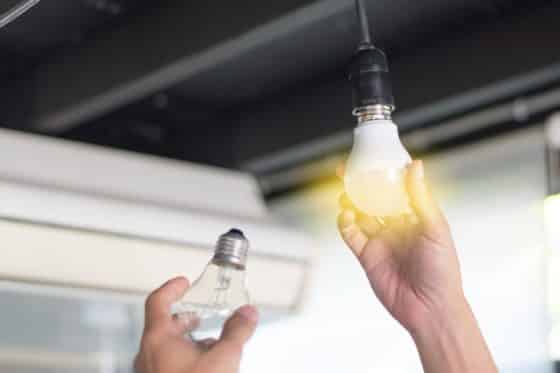Selecting the Best Energy-Efficient Light Bulbs

There are many reasons to choose energy-efficient light bulbs, not the least of which is that they can save you a lot of money. The average household spends $1,000 per year on electricity bills, and when you switch to energy-efficient bulbs, it will help reduce your monthly bill by 20%. How do you know what makes for an effective and efficient bulb with so many options out there?
What Makes a Light Bulb Energy Efficient?
There are a lot of factors that are considered before a light bulb is considered energy efficient. For starters, the light bulb should be able to produce the correct color of light. Not every bulb emits the same type of light, which can affect your mood and how you function.
The most important factor is the lumens (the total visible light emitted by a source). The higher number there is for lumens, the brighter and more energy efficient the bulb. The brightness is measured in lumens, which determines how much energy it takes to power the light bulb and affects its lifespan.
After lumen output comes watts (the rate at which energy is used). As a rule of thumb, you should look for bulbs that have a wattage significantly lower than your current incandescent bulbs.
Types of Energy-Efficient Bulbs
When you purchase your light bulbs, it’s also important to determine what type of bulb best suits your needs. There are three types that are considered energy-efficient:
- CFL
- LEDs
- Halogens
CFLs (Compact Fluorescent Lamps)
These types of bulbs are the most energy efficient of any light bulbs on the market. They last up to ten times more than standard bulbs and use one-third of the electricity, which means you will save more money on your monthly electric bill without sacrificing lighting quality or brightness.
LEDs (Light-Emitting Diodes)
LED lights are the most energy efficient and have a longer life span than any other bulb. They last up to 25 times longer, use one-tenth of the electricity as traditional bulbs, and are more durable under strenuous conditions, including high temperatures or constant vibration.
Halogens
Halogen light bulbs operate at a lower voltage but still provide bright illumination for your home or business. They use a fraction of the energy to operate and last up to twice as long, which means you will save money on your monthly electric bill without sacrificing lighting quality or brightness.
It’s important to note that fluorescent lights are available in three different forms: CFLs (compact fluorescent lamps), T12 tubes, and TUV tubes. CFLs are more efficient than the other types of lighting and offer a high-quality light compared to halogens or incandescent bulbs.
T12 Tubes fluorescent lights, like traditional bulbs, give off a white light and use much less wattage than any bulb. They last up to two times longer than standard bulbs and can last up to ten times as long as halogens.
Why Are LEDs the Best Energy-Efficient Light Bulbs?
LED bulbs are made out of solid-state components that are more durable than incandescent filaments. Incandescent bulbs are only about 14% efficient, while LED lights are up to 90%. LEDs are the best energy-efficient bulb for a few reasons.
1. Efficiency
They are very efficient when it comes to converting electricity into light.
2. Durability
They last a long time. Incandescent bulbs last about 1000 hours, while LEDs last up to 60,000.
3. Environment Friendly
LEDs are the most environmentally friendly option, as they contain no mercury or other hazardous materials.
4. Variety
LED lights come in different shapes and colors to fit any purpose you need them for.
Why Should I Choose LED Lighting?
There are various reasons why LED lighting should be your only and best option. The best reason to choose LED lights is the money you will save in the long run. You can cut your energy costs by a huge percentage when using LEDs.
LED bulbs are friendly to the environment, and you have a role to play in caring for it. One LED bulb will keep thousands of pounds of carbon dioxide out of the air during its lifetime.
LED bulbs are also very versatile. They provide bright and clear light in different colors. You can easily use them for matching your decor or for whatever purpose you need them for.
Lastly, LEDs are now more affordable than ever before. You can get high-quality LED bulbs at affordable prices.
Is Switching to LED Light Bulbs Worth It?
Apart from saving money, switching to LED light bulbs is one of the best ways you can help save our environment. Fluorescent bulbs contain mercury, a chemical element linked to the development of neurological disorders and other diseases.
They also contain harmful substances such as phosphor, chlorine gas and sulfuric acid. On the other hand, LED bulbs are mercury-free, and they produce less heat than incandescent light bulbs, which means that they are safer and more efficient.
They also last longer (up to 50,000 hours), which means that you don’t have to keep replacing them often. As compared to regular bulbs, LED light bulbs might appear more expensive, but they last longer. The price of LED light bulbs is also expected to drop soon, making them even more affordable.
The best part is that they consume less electricity. They are highly energy efficient, and if you use them in your home or office, then the chances are that you will never receive a huge electricity bill.
LEDs’ long life span, low cost per unit, and energy efficiency make it the best energy efficient and no.1 choice for most people. Energy-efficient light bulbs are good for your wallet and can help you save money.
Steps for Choosing the Best Energy-efficient Light Bulbs
There are three steps involved:
- Determining
- Comparing
- Deciding
Determine the wattage of your current light bulbs. The average incandescent bulb is 60 watts. Determine the number of hours each day that you use your light bulbs. If it’s near or over ten hours, then you will want to consider energy-efficient light bulbs. Determine the lighting quality that is expected in your home. Different light bulbs are better for different scenarios.
Compare the energy-efficient light bulbs to your bulb wattage. If you use a higher wattage than the energy-efficient light bulbs, they may not be for you as it will take longer to see the energy savings. Compare your current bulb wattage to an LED light bulb with similar wattage. If your current wattage is lower than the LED light bulb, then you will see greater energy savings with an LED bulb. Compare your bulb wattage to an LED light bulb with a lower wattage. You will see less of a jump in energy savings if you choose this option, but the LED light bulb may last longer. Compare your bulb wattage to an LED light bulb with a higher wattage. If you choose this option, then your savings may be lower.
Decide which energy-efficient light bulb option is best for you. It’s important to note that though the wattage and energy-efficient light bulb option is higher, the LED will be brighter than your current incandescent bulb. Determine the lighting quality that is expected in your home. Different light bulbs are better for different scenarios.
Brennan Electric is an excellent choice for all your electrical needs in Seattle and the surrounding areas. We also offer surge protection and generator services. Our team of electrical experts can help you select the best option for your home or business. Give us a call or visit our website for more information.

